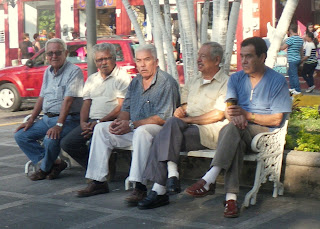Los Voladores de Papantla
Flyers of Papantla
Several years ago, Alice and I drove our little Tsuru to Merida. We stopped in Papantla to see the beautiful pre-Colombian archaeological site, El Tajín, and we bought a bunch of fresh vanilla beans. While searching for fresh vanilla beans in the centro street markets, we encountered the voladores, the fliers. We saw them 'flying' in downtown Papantla - and it was an awesome site. There was a big hawk circling above them, and the bird seemed to be responding to their flute playing and drum beating. I took a bunch of pictures you can see here (https://plus.google.com/photos/102326992936227885261/albums/5468952612170978929?banner=pwa).
Since we have been in Puerto Vallarta, we have heard that voladores also 'fly' here. But despite locating their 30 meters ( 98 feet) high pole between the ocean and the malecon, we had not been able to find them performing. The tourist police told us that they came there every afternoon at four-thirty. Not true. Another person said that they only perform when a cruise ship is in port. Yet another told us that they didn't come if it was too windy or too hot. Others said that since it was now hotter in the afternoon, they would come much later in the afternoon - close to dark.
Finally, yesterday - the fourth time we had tried to catch the rascals, we went to that spot beside Bahia de Banderas where they were alleged 'fly'. They were not there, but a man at nearby Chico's Dive Shop told us they would be there in an hour or so.Time can be indefinite in Mexico. So, we walked along the malecon for the next hour. I bought a cup of corn in a chipotle salsa and we looked at people.

After about ten minutes, they climbed the pole. They
wound four long ropes around the top of the pole. Then one played the
flute, chanted and beat a small drum as he sat and then stood atop the
pole.
The ceremony begins with a dance and song type called a son. Usually the initial song played and danced to is called the son of forgiveness. After this, the five men climb the pole with the chief or caporal going first. The caporal will not descend but rather will stay at the top of the pole until near the end of the ceremony. The caporal stands on the manzana (apple) which is a small platform at the top of the pole. From this capstan is suspended a square frame called a cuadro (square) on which the other four voladores sit.

When we returned to the site, the voladores were just finishing their flight. We arrived just in time to see them touch down.
Before we could even cuss, the guy who works in Chico's stepped up and asked if we had missed the show. We told him yes, and he informed us there would be another performance shortly.
The men reappeared in their traditional
native costume. The Totonac dress for this ritual consists of a red pants with a
white shirt, a cloth across the chest and a cap. The pants, hat and chest cloth
are heavily decorated with embroidery. The cloth across the chest
symbolizes blood. The hat is adorned with flowers for fertility, mirrors represent
the sun and from the top of the pole they fly from stream multicolored ribbons representing the rainbow.
The ceremony begins with a dance and song type called a son. Usually the initial song played and danced to is called the son of forgiveness. After this, the five men climb the pole with the chief or caporal going first. The caporal will not descend but rather will stay at the top of the pole until near the end of the ceremony. The caporal stands on the manzana (apple) which is a small platform at the top of the pole. From this capstan is suspended a square frame called a cuadro (square) on which the other four voladores sit.
Suddenly, the four literally fall head over heels off the top of the pole,
dangling by just one of their ankles from a rope. The voladores gracefully spin
and flutter around the pole as their individual ropes unwind swinging them into a wider circle until they reach the ground.
This
whole "performance" is an important religious ceremony dating back 1500 years. The ritual started
in central Mexico in honor of the God of Sun, for the purpose of boosting that
year's harvest and improving fertility. The voladores represent fire,
earth, water, and air. As they “fall” from the top of the pole, their arms are
outstretched and their heads point towards the ground. The flutist on top of
the pole begins the ritual by facing east, symbolic of the origin of the world.
Each volador spins thirteen times around the pole before reaching the ground.
13 spins x 4 flyers = 52, and 52 years, according to the Mayan calendar,
encompasses one solar cycle. Of course, 52 weeks makes a year, which symbolizes
the birth of a “new sun.”







































